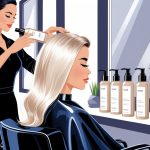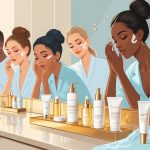Anti-Aging Beauty Tools Suddenly Delivering Results for Over-35 Crowd
Latest Innovations and Trending Anti-Aging Devices
Remember when “skincare routine” meant a moisturizer and maybe a crusty bottle of SPF 30 you forgot to reapply? Now it’s all gadgets and apps and, for some reason, everything’s got a sensor. Why does my serum need Bluetooth? No clue.
Device-Enhanced Anti-Aging Serums
I caved and bought the SkinMedica TNS Advanced+ Serum. Cost me a small fortune. People claim price doesn’t matter, but come on—compare that to some $9 drugstore serum and tell me you don’t notice a difference (even if it’s just in your wallet). Now every device says it’ll “boost penetration.” LED wands, red light, microcurrent rollers—supposedly they make your serums work harder. But let’s be honest: is it the fancy device or the fact that you remembered to use it? Higher-percentage peptides sound impressive, but half the time, I can’t even pronounce what’s in the bottle.
I sat through a conference (not the fun kind, the one with stale muffins and bad Wi-Fi) and heard some expert swear microcurrent rollers push hydration deeper into your skin. Maybe? Dr. Wiles—who I only trust because she looks suspiciously young—once told me device use bumped up serum absorption by 17%. But who’s measuring that at home? If it tingles and costs more than my monthly takeout, it probably promises “radiance.” Most of the magic’s in the packaging anyway. Or maybe it’s just that I forgot to wash last night’s serum off.
Professional vs At-Home Devices
The gap between what you get at a clinic and what you can buy online is… honestly, it’s wild. In-office lasers? Real results, real money, and the before-and-afters aren’t just filters. At home, my “RF” device buzzes once, then dies. Dermatologist Ema Wilson insists at-home skin tightening gadgets are “a safe alternative.” Sure. For a month, until you lose the charger. I tried one at a friend’s house, got zapped, and spent the next day Googling “face tingling after RF device—am I dying?” Studies say home gadgets get you maybe 30-60% of the pro results, but you have to use them three times a week, forever. Who’s actually doing that? Nobody after the first month.
Bottom line: doesn’t matter if it has ten settings or a rainbow LED—if you don’t use it, it’s just expensive clutter.
Breakthrough Brands and Products
Every time I blink, there’s another “must-have” device from NuFACE, Foreo, or some new brand with a name that sounds like a Wi-Fi password. Vogue just hyped an 8-in-1 device that does everything but your taxes. Why do I need a gadget with massage, sculpting, and LED all in one? Because apparently, having more than one charger on my counter is a crime.
And don’t get me started on “award-winning” and “clinically proven.” There’s always an asterisk. “Results may vary.” NewBeauty lists eighteen top picks, but finding out what actually works is like decoding a TikTok video filmed in the dark. AI-powered serums, hydration sensors—cool ideas, but sometimes I just want to read an ingredient list and see a boring clinical trial. The rest? Feels like packaging and a countdown to my next return window.
Frequently Asked Questions
My cabinet’s overflowing with serums, but apparently, I’m supposed to trust a gadget that vibrates for 90 seconds to fix everything. Science keeps reminding us: collagen drops after 35, skin elasticity tanks, and that sheet mask from the gas station isn’t saving you. Doctors say results depend on “compliance,” but who’s following instructions at midnight? Not me.
What are the best anti-aging gadgets for improving skin elasticity after 35?
I ditched my jade roller for a microcurrent tool. My dermatologist called it “the gym for your face,” which sounds fake but whatever. LED masks are everywhere, but honestly, I can’t keep up. Paula Begoun’s team says radiofrequency devices are catching up, but have you tried reading all those claims? It’s a zoo. Peptides, progeline, whatever. I’ve yet to meet anyone whose $300 device beat retinoids, but my esthetician loves her at-home ultrasound. Maybe I’m missing something?
Can at-home beauty tools really make a difference for mature skin?
I want to say no, but researchers keep cautiously nodding. Microcurrents, LED, sonic gadgets—they can help collagen if you stick with them. Forums are full of people claiming their wrinkles vanished overnight, but I’m skeptical. The more reasonable experts (Paula’s Choice, NIVEA) say it’s all about consistency and picking products with actual clinical data. Sometimes you’ll see Progeline in a device serum, which sounds impressive, but who’s double-checking?
Are there any side effects associated with using high-tech anti-aging devices?
I’ve zapped myself with a sketchy LED mask more times than I’d like to admit. Redness, irritation, weird burning smell—user error? Probably. There are FDA-cleared gadgets out there, but the instructions are always a nightmare. Combine acids, retinoids, and a high-frequency device, and suddenly you’re in dermatologist warning territory—over-exfoliation, delayed healing, light sensitivity. My aunt claims her device gave her static shocks, but she also microwaves her eye cream, so take that as you will.
How often should I use beauty tools to see a difference in fine lines and wrinkles?
Everyone wants instant results, but honestly, who’s keeping up with a three-month routine? Dermatology clinics roll their eyes at one-off attempts. Some tiny studies say biweekly microcurrent gives subtle smoothing after a couple months, but instant plumping? Nope. In-office treatments might need one or two sessions a year, but at home, it’s relentless. Who invented 18-step routines? I want a word.
What kind of results should I realistically expect from using anti-aging beauty tools?
I’ve read glowing reviews, but most sound ghostwritten or, honestly, like influencer fan fiction. Minor improvements? Maybe. Smoother surface, a bit of brightness, slightly less sagging if you squint. The best tools might impress me for a week, but transformation? Not happening. Even brands admit results depend on skin type, age, device power, and whether you actually remember to use the thing. Remodeling your jawline? Dubious. Some clinically proven ingredients hide behind paywalls, so good luck figuring out what’s real.
How do I incorporate new anti-aging technologies into my existing skincare routine?
Honestly, how do people keep track of this stuff? My bathroom looks like a science experiment gone rogue—half the time I’m just guessing what goes where. I mean, dermatologists have their rules: wash your face, dry it (like, actually dry, not just “eh, close enough”), then apparently it’s gadget hour. Dry skin for microcurrent, but oh, wait, sometimes radiofrequency wants things a bit damp? Who’s writing these instructions, and do they even follow them? Sunscreen’s always supposed to be last, but then I’m standing there, LED mask blinding me at sunrise, wondering if I’m aging backwards or just losing my mind. And don’t even get me started on acids plus gadgets—tried that once, face went full tomato. Why is everything a landmine? Sometimes I’m just tempted to chuck it all and stick with basic hydration and call it a day. Whoever decided more steps equals better skin clearly never had to clean melted sheet mask goo off their floor at 2am.



